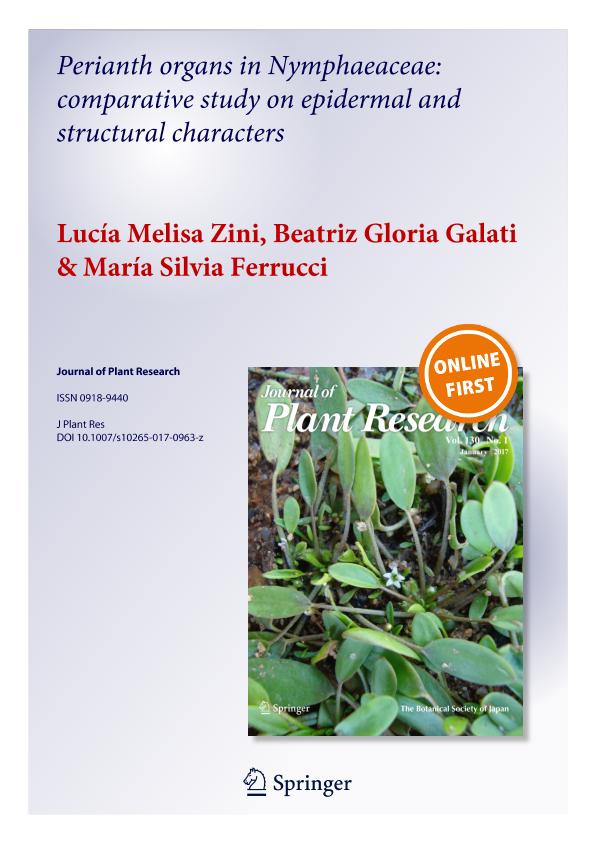Mostrar el registro sencillo del ítem
dc.contributor.author
Zini, Lucia Melisa

dc.contributor.author
Galati, Beatriz Gloria

dc.contributor.author
Ferrucci, María Silvia

dc.date.available
2017-12-04T21:38:52Z
dc.date.issued
2017-07
dc.identifier.citation
Zini, Lucia Melisa; Galati, Beatriz Gloria; Ferrucci, María Silvia; Perianth organs in Nymphaeaceae: comparative study on epidermal and structural characters; Springer Tokyo; Journal of Plant Research; 130; 6; 7-2017; 1047-1060
dc.identifier.issn
0918-9440
dc.identifier.uri
http://hdl.handle.net/11336/29672
dc.description.abstract
The perianth organs of six species of Nymphaeaceae, representing Euryale, Nymphaea and Victoria, were studied on the basis of macroscopical, micromorphological, and anatomical characters. The aims were to determine whether perianth is differentiated among tepal whorls considering the presence of sepaloid and petaloid characters, and to evaluate the occurrence of both features in individual tepals. Selected perianth series were examined macroscopically, with light microscopy, and scanning electron microscopy. Osmophores were detected using neutral red and Sudan. In all tepals examined, stomata and hydropotes were present on the abaxial and adaxial surfaces. These are anomocytic or stephanocytic; hydropotes of irregular type are also present. The outer series of tepals display morpho-anatomical characters in most part related with photosynthetic and protective functions. Osmophore activity is very scarce and petaloid epidermal morphology is present only in N. lotus, thus allowing interpretation of this whorl as primarily sepaloid. The second series exhibits both petal-like and sepal-like characters; in N. amazonum and N. gardneriana sepaloid and petaloid group of cells are present on the abaxial surface of individual tepals. Therefore, this whorl is transitional between the outer and the innermost ones. Both the morpho-anatomy and presence of osmophore activity indicate that the innermost series is entirely petaloid. Inner tepals of E. ferox, N. alba, and V. cruziana share the presence of epidermal cells with predominantly smooth cuticle, whereas those of N. amazonum, N. gardneriana, and N. lotus share a cuticular ornamentation consisting of numerous papillae on each cell. Morphological characters of the perianth epidermis are in some respects congruent with the molecular phylogeny of Nymphaeaceae. Our results support the co-expression of sepaloidy and petaloidy within individual tepals and the mosaic model of perianth evolution proposed for the angiosperms.
dc.format
application/pdf
dc.language.iso
eng
dc.publisher
Springer Tokyo

dc.rights
info:eu-repo/semantics/openAccess
dc.rights.uri
https://creativecommons.org/licenses/by-nc-sa/2.5/ar/
dc.subject
Anatomy
dc.subject
Cuticular Ornamentation
dc.subject
Euryale/ Nymphaea/Victoria
dc.subject
Perianth
dc.subject.classification
Otras Ciencias Biológicas

dc.subject.classification
Ciencias Biológicas

dc.subject.classification
CIENCIAS NATURALES Y EXACTAS

dc.title
Perianth organs in Nymphaeaceae: comparative study on epidermal and structural characters
dc.type
info:eu-repo/semantics/article
dc.type
info:ar-repo/semantics/artículo
dc.type
info:eu-repo/semantics/publishedVersion
dc.date.updated
2017-11-24T13:39:32Z
dc.identifier.eissn
1618-0860
dc.journal.volume
130
dc.journal.number
6
dc.journal.pagination
1047-1060
dc.journal.pais
Japón

dc.journal.ciudad
Tokyo
dc.description.fil
Fil: Zini, Lucia Melisa. Consejo Nacional de Investigaciones Científicas y Técnicas. Centro Científico Tecnológico Conicet - Nordeste. Instituto de Botánica del Nordeste. Universidad Nacional del Nordeste. Facultad de Ciencias Agrarias. Instituto de Botánica del Nordeste; Argentina
dc.description.fil
Fil: Galati, Beatriz Gloria. Universidad de Buenos Aires. Facultad de Agronomía; Argentina
dc.description.fil
Fil: Ferrucci, MarÍa Silvia. Consejo Nacional de Investigaciones Científicas y Técnicas. Centro Científico Tecnológico Conicet - Nordeste. Instituto de Botánica del Nordeste. Universidad Nacional del Nordeste. Facultad de Ciencias Agrarias. Instituto de Botánica del Nordeste; Argentina
dc.journal.title
Journal of Plant Research

dc.relation.alternativeid
info:eu-repo/semantics/altIdentifier/doi/http://dx.doi.org/10.1007/s10265-017-0963-z
dc.relation.alternativeid
info:eu-repo/semantics/altIdentifier/url/https://link.springer.com/article/10.1007%2Fs10265-017-0963-z
Archivos asociados
